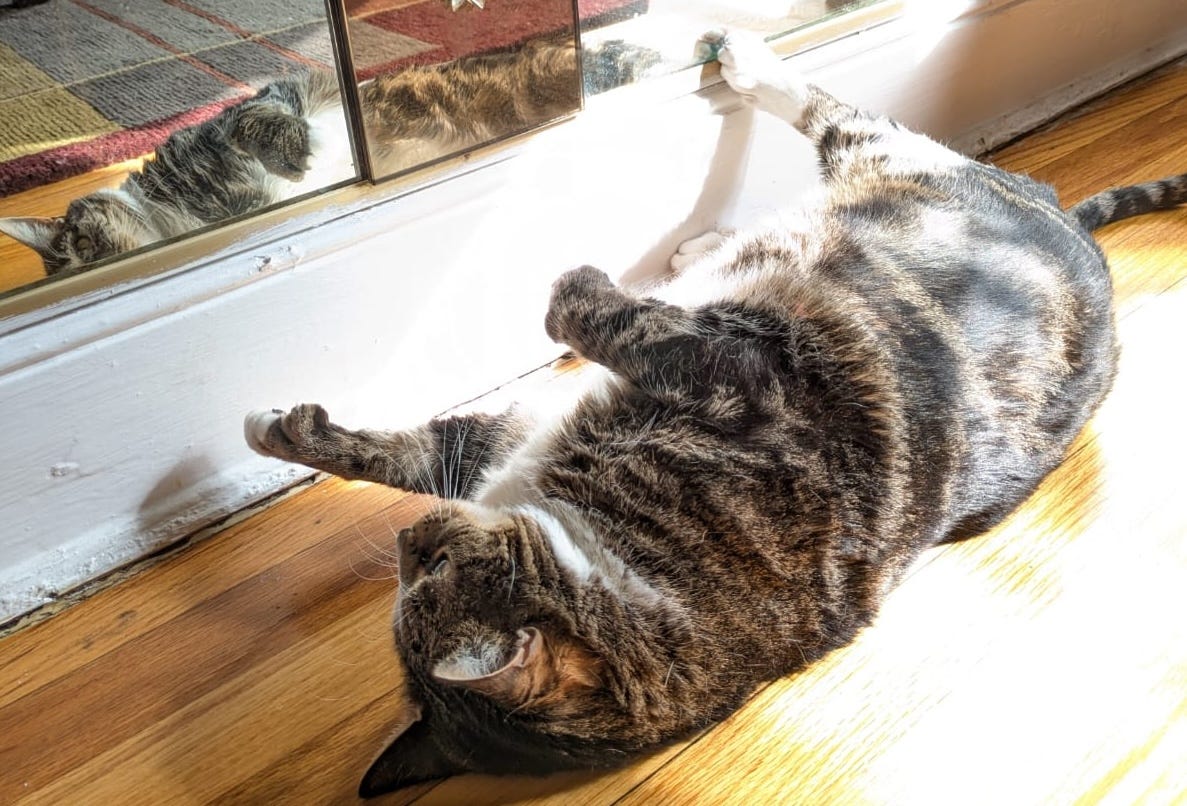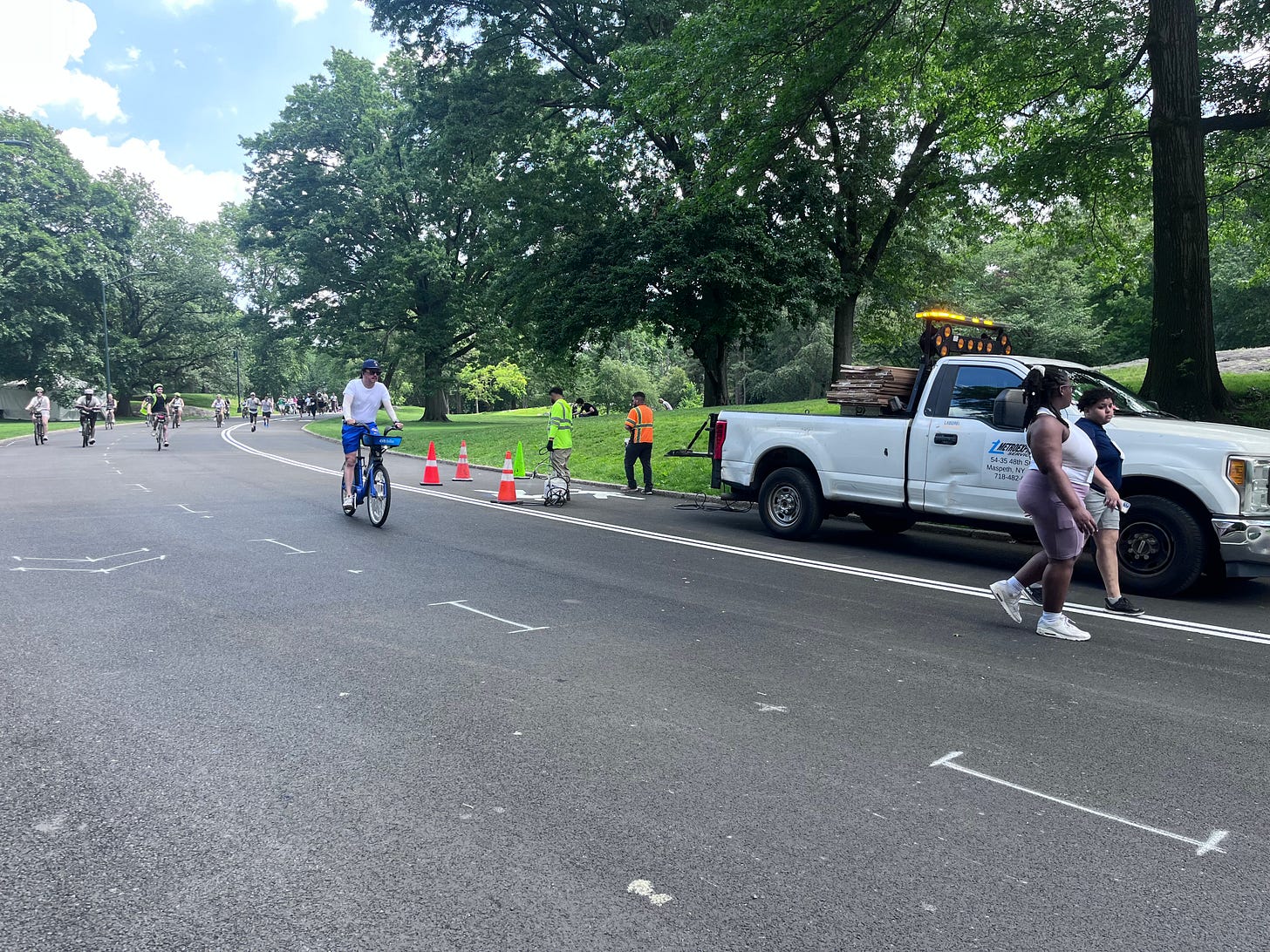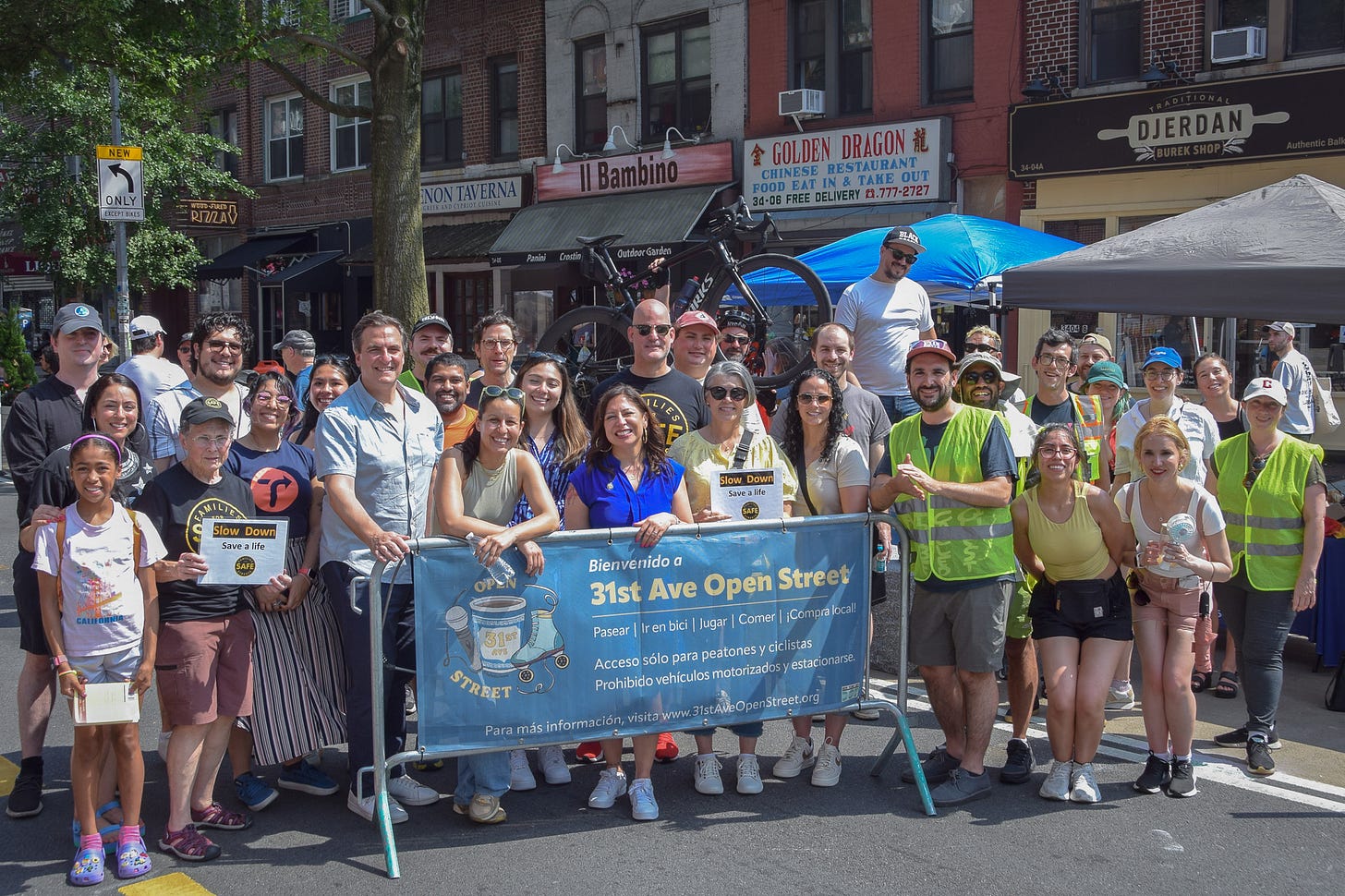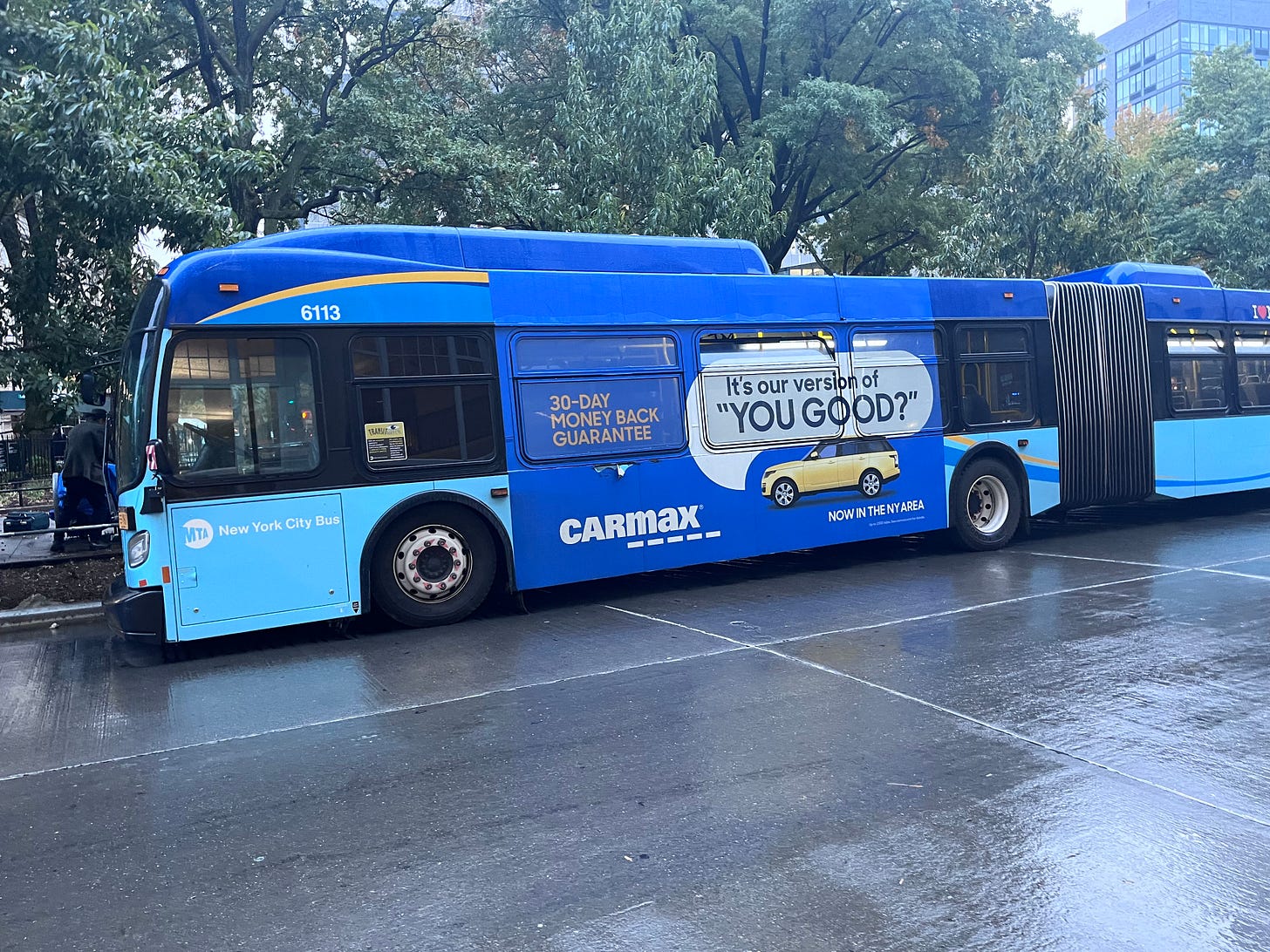Cia’*
And welcome to this newsletter.
It's where I (John Surico) talk each month about cities & their discontents: streets, climate, cultures, people, food, form, etc. This month, we cover:
- Parks vs. transit;
- Post-pandemic buses;
- A new chapter for the Open Street;
& much, much more.
Editorial note: I first met Zohran Mamdani in 2022. By then, he had already shocked Western Queens politics by toppling an incumbent to become our district’s state assembly member, mid-pandemic, with little to no name recognition. He tapped into the same coalition that catapulted AOC to Congress, Tiffany Cabán to City Council, and later, Kristen Gonzalez to the State Senate: an energized base made up of diverse worlds—young, mutual aid friendly, establishment-skeptic, queer, urbanist, even sometimes YIMBY—fueled by an impressive ground game, courtesy of the Democratic Socialists of America (DSA). (This lineup has inspired the title, ‘The People’s Republic of Astoria.’)
Even as a nonpartisan 501(c)3—don’t worry, IRS!—the 31st Ave Open Street Collective has been adjacent to that movement since we started. The public space we’ve created is perhaps most activated and utilized by that same base, given naturally shared interests and politics. Mamdani included: often, he’d canvas with us on weekends; stop by with his partner, illustrator Rama Duwaji; and, later, allocate grant funding to scale up our programming and operations.
Mamdani’s past advocacy for a crucial bike lane project nearby was an early education in livable streets organizing. Once in office, he was a regular at the public workshops for 31st Avenue. He attended meetups with just a handful of local advocates. And, in 2023, his office worked with us on the Western Queens Street Safety Plan, which posits Astoria as a model for what our streets can be. He has repeatedly shouted-out the work we do on the Open Street, to which we are endlessly grateful. (Thanks for letting Hasan Piker know about us.)
Last Tuesday, the rest of the country met Zohran Mamdani, when, once again, he shocked national politics by toppling a incumbent to become New York City’s Democratic nominee for mayor, with little to no name recognition. I’ll have much more to say about his campaign in the months leading up to November’s general election. But in the meantime, I’ll leave it at this: I know Zohran to be someone who truly knows and loves cities—who doesn’t see New York as somewhere that needs to be “cleaned up,” but rather, a place like no other that has the potential to thrive even more. And while his victory is now America’s biggest political story, it’s one that started in our own backyard, giving new meaning to a phrase heard often around these parts: Queens is the future.
Green corridors
Who—or what—are parks meant for? People have been debating this question for as long as there have been parks. But in recent years, answering it has taken on renewed urgency on the issue of mobility, as we navigate a paradigm shift in how we move around, akin to the transition from human feet to horse carriage, horse carriage to bicycle, and bicycle to automobile—all of which upended park design in their day. That, of course, is the era of electric micro-mobility.
I see the contours of this everywhere in New York City. I recently helped edit a proposal for a linear park in Queens dubbed Paseo Park. And this question—do we allow fast e-bikes?—was a central theme, as if in conflict with the Spanish word for stroll. (Their answer: yes, but maybe somewhere else.) Further south, the city’s parks department faced concerns that this new fleet of e-vehicles had turned a seaside boardwalk into a highway. (Their answer: no more.) And on Staten Island, a pandemic-era ban on driving in a popular park spurred a MAGA-coded backlash after a jogger was sexually assaulted. Less cars and more bikes, they argued, had made it perilous. (Their answer: yes, but only on weekends.)
But there is perhaps no greater arena for this argument to unfold than the busiest urban park in the city, née the world. In 2022, during my time at the Central Park Conservancy, the surge in physical activity along the park’s 6.1-mile-long loop—otherwise known as ‘the Drives’—had become a pressing issue amongst visitors and staff. With most cars banned in 2018, a space that sees almost 50 million people a year was now regularly awash in movement of varying speeds and sizes, but the 'Drives' still prioritized its namesake. A refresh was clearly in order.
Now, years later, I'm thrilled to tell that story for Bloomberg CityLab, as the Conservancy weighed that aforementioned question, which is as old as the park itself. I followed work crews as they repaved and re-striped the loop for the first time in decades; heard from other cities experiencing the same dilemma of division; and called up the advocates challenging the city to think big. The solution, should it work, could serve as a model as parks try to be all of the things to all of the people. You can read the full story here.
Bain of existence
There are very specific moments I can recall in my life when I felt truly overwhelmed by something I saw. I’d describe this emotion as the opposite of the sublime: rather than a scene that sparks utter joy or happiness for being alive, it instead induces fear and despair for what we exist alongside. And a memory that certainly qualifies for me is the time I turned a street corner in the Bronx, and the Vernon C. Bain Correctional Center came into view.
VCBC—or known more notoriously as “The Boat”—is a 625-foot jail barge. Boasting a 870-person capacity, it’s absolutely colossal, with a brutally blank austere of gray and blue. It looks like the movie Waterworld if you were to distill it into maritime form. The floating correctional facility rolled onto the shores of Hunts Point in 1992 to reduce the inmate count at Rikers Island, America’s largest municipal jail just across the water, after it ballooned in number thanks to the then-growing fervor for broken windows policing. Just to repeat this for good measure: New York City was locking up so many people, they had to literally bring in a boat to make space. And it stayed there, in active use, until 2023, when it was decommissioned.
In 2015, I visited VCBC for VICE, to report on how arduous it was for family members and loved ones to bail out someone who was behind bars. (Reminder: VCBC and Rikers are jails, not prisons, meaning everyone there is awaiting trail, not convicted.) It was far. It was cash or cashier’s check only. And it was one of only four places in the whole city where you could directly post bail. VCBC, with its history of unjust death and squalor, was this living embodiment of the everyday cruelty America’s criminal justice system exacts on its most vulnerable. And I’ll never forget what it was like to visit then.
Ten years later, though, this blemish on our social conscience is finally being removed. This month, City Hall announced that the ship would soon leave port, never to return. It would be replaced by a marine freight terminal as part of the city’s “Blue Highways” initiative, where waterway freight is offloaded onto cargo e-bikes and other micro-mobility vehicles, in lieu of big, polluting trucks. It’ll never erase the legacy of lives taken, families who suffered, and all who had to ever make the trip there. But it’ll ensure future generations will never have to.
OSA: Victory
This month marked the completion of the 31st Avenue ‘bike boulevard.’ The two blocks that we close to car traffic on weekends, from April to December, are now, officially, mini-plazas. And a joy of late has been finding people sitting and chatting on the big granite blocks late on weeknights, or walking without worry in the middle of the street at all hours. It has been emotional, to say the least. A time-lapse video I made—of how we went to a few tables and chairs with lawn games to what we are today—made me teary-eyed. We have come so far.
And so, we’ve been celebrating. A few weekends ago, we invited elected officials, local advocates, families who have lost love ones to traffic violence, and organizers to commemorate the occasion. As the Collective’s chairperson, I emceed (eek!) what ended up being a big ol’ block party, and so I’m resharing a revised version of my opening remarks here:
In 2020, as the pandemic ravaged New York, Astorians needed space—not just to freely walk or bike, but also, to check in on friends, breathe fresh air, and see one another. The world felt inconsolable and, instead of wallowing away, our neighbors looked locally for a solution. They applied for a new program being created then called Open Streets, and the rest, as they say, is history.
We started with six blocks, seven days a week. Volunteers dragged barricades out to the street and hoped they stayed intact, from 8am to 8pm. As we learned the Avenue’s daily patterns and our own bandwidth, we decided to double down on these two blocks the next season. And people kept coming—to throw birthday parties, to host classes, to learn how to ride a bike, to perform, to barbecue, or merely just to sit and take it all in.
Now, five years later, the 31st Ave Open Street Collective is made up of over 250 volunteers—and that’s not counting every programmer, entrepreneur, or performer who help make this space happen 36 weekends straight a year. We’re a certified nonprofit, which allows us to fundraise and expand what we’re able to deliver to neighbors entirely for free. And we receive regular support from the Horticultural Society, our elected officials, and NYCDOT.
But most importantly: for five years straight, we’ve shown what’s possible when you create streets for people. Public spaces based around the concept of joy, even when it can feel like everything else at the moment is lacking in it. A place where community can come together, not break apart. And I like to point out that I’ve lived in Astoria for over a decade, and I didn’t know any of these people here today until just a few years ago. And now, I consider so many of these strangers close friends, in what has been one of the most fruitful experiences of my life.
Today we’re here to celebrate the true culmination of that effort: a brand new “bike boulevard” that bakes our successes into the streetscape itself. A 31st Ave that is calmer, safer, and more livable for all—Astoria’s front yard, backyard, and living room. But this work never happens alone. I want to give out a shout-out for our partners at NYCDOT for their seamless execution of this ambitious street redesign. And I want to thank our elected officials, who, at every turn, supported what we were doing and urged us to keep going; that the fight for safer streets and for joyful public spaces is worth it in the end.
Bright Side: Express Bus
Yesterday, the bus network for the place I call home began to change. Lines were amended. Rush routes were added. Stops were streamlined. It’s the first major overhaul of my borough’s surface transit since it replaced the streetcar decades ago. By summer’s end, a map serving 2.3 million people will look different.
On a trip this month to Washington D.C., I came across a sign at bus stop in Mt. Pleasant, where I was staying, that read: “All Metrobus Routes and Schedules Will Change.” Ironically, on the exact same day as Queens, the Capital’s bus network would also see its first facelift in 50 years. ‘Better Bus’ had arrived.
Gradually, the post-pandemic transit landscape is starting to take shape. The public health crisis upended commuting patterns, forcing a reckoning at transit agencies as they faced down spiraling revenue. The result: a return to the local. Like the 49 bus in West Philly, SEPTA’s first new addition in two decades, which linked a residential neighborhood to an emerging job hub. While ridership fell, the 49’s grew, with the fastest Covid-era rebound in the whole system.
I think back often to a 2021 profile I wrote in MIT Tech Review of Tiffany Chu, then the co-founder of Remix, the preeminent planning platform, and now chief of staff to Michelle Wu, Boston’s bus-riding mayor. Her argument was simple: what if the pandemic actually makes transit better, by refocusing our attention on where people want to go rather than where we expect them to go? The experiment to find out, it seems, is finally underway.
On the Radar
Miami in the Anthropocene, by Stephanie Wakefield
Recently, I was invited to join the Judging Committee for The Pattis Family Foundation Global Cities Book Award, hosted by Metropolis. Or, as I’ve been telling people: I got asked to read a lot of books about cities this summer and give my opinion on them, which I gleefully accepted. But at the heart of the contest is this idea that in a confusing and complicated world, long-form narratives can help break down complex issues for a wider audience, and, in doing so, inspire us to think big—which, ultimately, I can get down with.
One of the texts that has stood out thus far transports us to Florida. Miami, the author posits, is this living laboratory of climate action, warts and all. It’s where the ultra-rich complete for land that will likely be under water in our lifetime, low-income residents evade displacement without the privilege to relocate, and ‘solutions’ are tested at a grand scale.
Although it sounds overly academic at times, Wakefield’s book puts forward a compelling narrative that casts the city as a frontline for what comes next. In a way, Miami is the extreme. So if we can crack what’s happening there, maybe we can hash out ideas that are equal parts workable and equitable elsewhere.
Streetbeat Gig Board
Another neat gig from the Metropolitan Transportation Authority (MTA): head of its dinosaur-bodega-creating arts and design team. (New York, NY)
And again, up in the Bronx: the Bronx River Alliance—yes, there is a river in the Bronx—needs a director of environmental justice. (The Bronx, NY)
NACTO, the preeminent transit leadership body in the U.S., is hiring a program associate for engagement. (Remote/hybrid)
World may be on fire, but climate comms jobs are all the rave.
***
Tell us where the jobs are at by submitting them here.
Kita Monthly









